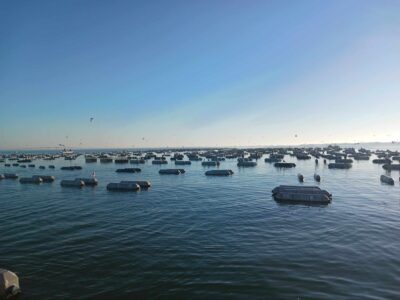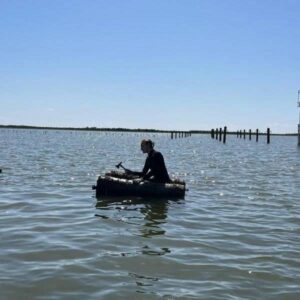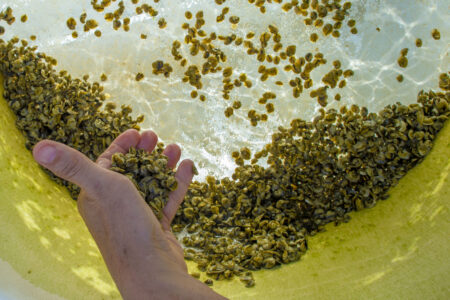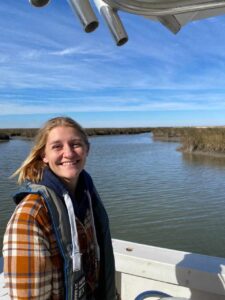By Kayla Boyd*

OysterGro floating cages at an oyster farm north of Dauphin Island, AL
Photo Credit: Kayla Boyd
It is impossible to stand on the shores of the Gulf of Mexico coastline and not be in awe of its beauty and history. From the sand dunes to the marsh, the shoreline alone is teaming with a wide diversity of flora and fauna. Just as diverse but unseen, the waters of the coastal south have sustained people living here for millennia. Although unassuming, oysters are foundational to the health of the coast. Oysters are a keystone species, providing many ecosystem services. Their reefs provide critical habitat for fish and invertebrates and wave attenuation to reduce erosion from the Gulf of Mexico’s fierce temperament during summer storms. The oysters themselves improve water quality via filtration and serve as vital prey for other species. To people, oysters have been harvested globally since the beginning of time. However, in recent decades, human impacts have taken their toll on the reefs in the Gulf of Mexico from factors such as overharvesting, degraded water quality from urbanization, and dredging oyster shell for construction materials and has left our wild reefs nearly nonexistent compared to their historical abundance.

Kayla removing biofouling organisms (barnacles and algae) from a floating cage with a hatchet
Photo Credit: Annie Hollister
Reef deterioration along our southern coastline has resulted in reduced limits on traditional harvest, increasing oyster prices for the consumer market and putting generational traditional oyster harvesters out of work. In response, oyster aquaculture was introduced to the Gulf of Mexico and has increased in popularity. Oyster farming is a unique form of aquaculture in that it takes place in ambient coastal waters and almost solely relies on the natural environment to grow their animals. Farmers put their complete faith in nature, praying for moderate salinity and a healthy community of algal cells in the water column to feed their crops. However, estuaries are harsh and unpredictable, sometimes resulting in rapidly shifting temperatures and salinities, sudden large storms, low dissolved oxygen events, and algal community crashes that can completely decimate their crops suddenly and unexpectedly. One can’t help but admire the determination of anyone working in oysters.
Oyster aquaculture is not only a valuable economic fishery in Alabama. Because oyster farms are in ambient waters, they fill an ecological niche that has disappeared with the loss of our wild oyster reefs. The lack of consolidated substrate has resulted in slow oyster population recovery due to larval oysters needing hard surfaces to attach to. Through the introduction of oyster aquaculture, which provides structure for larval oyster settlement, and current reef restoration efforts, we have seen a resurgence in biodiversity around coastal Alabama.

10mm single-set oysters spawned and raised at the Auburn University Shellfish Lab
Photo Credit: Kayla Boyd
Pho
While commercial oyster farming is not without its challenges, it has opened doors for a new economy built around sustainability for commercial harvesting and identifying new restoration methods. Oyster aquaculture has also developed a community driven by passionate individuals who do not necessarily see the market as competition against each other but come together to help each other in their challenging times and celebrate in the best of times. Not only does this include farmers, but also NGOs working on oyster reef restoration, agencies providing support where they can, and academics providing crucial research to improve management practices in this new industry. All these stakeholders come together frequently for festivals, conferences, and workshops to solve industry-wide problems and celebrate these benthic organisms as we all recognize the importance of these animals to our well-being as a society.

Kayla surveying possible intertidal oyster reef restoration sites around Dauphin Island, AL with Rusty Grice and Alabama Marine Resources Division
Photo Credit: Rusty Grice
It is commonly stated that you need to be a little crazy to get into oysters, and that holds true for both aquaculture and research. The Auburn University Shellfish Laboratory on Dauphin Island, Alabama is a unique facility in that we care for oysters at all life stages from raising larvae for restoration and aquaculture to conducting research that will assist in both, and working on our research farm just as farmers do. As an extension campus, we also work closely with all stakeholders to improve communication across the industry, including working the water ourselves when farmers need a hand. As a rural Wisconsin native, I was oblivious to the rich cultural, economic, and ecosystem services oysters provided until I moved to coastal Alabama. It was not until I became a part of this community myself that I, too, became enraptured by this animal and the community surrounding them. To be a steward for this watershed is a great honor. I am grateful for the opportunity to explore this area from the headwaters in north Alabama, the delta, and the surrounding coastal waters to learn all I can about Alabama’s rich biodiversity and complex ecosystem because I believe it is something worth treasuring and preserving for generations to come.
Oysters are the lifeblood of the coastal south for the services they provide to our coastal ecosystem, local economy, community, and well-being as individuals. Spending time on the water and working hand in hand with nature brings about a sense of peace, fulfillment, and pride that I have yet to find in any other industry. I have found that there is no greater feeling than standing on the beach after a long day’s work, the sun glittering amongst the waves with my hands torn and scarred by razor-sharp shells and barnacles, and admire the care put into growing these animals to keep a part of the coastal south alive in a sustainable way.
*Kayla is a graduate student & PhD candidate in the School of Fisheries, Agriculture, & Aquatic Sciences




